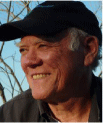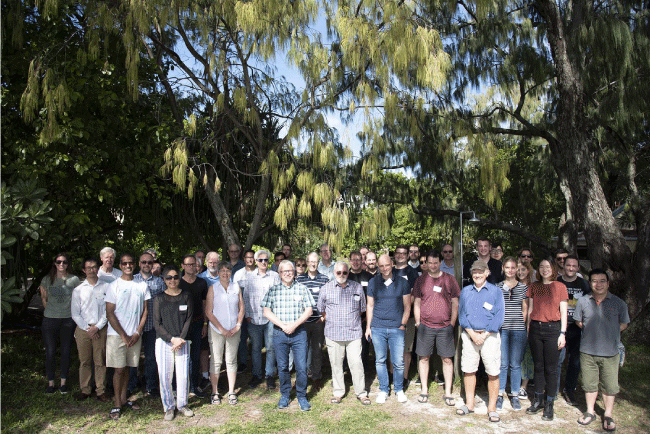Reactive intermediates and unusual molecules at Heron Island
Curt Wentrup A *A School of Chemistry and Molecular Biosciences, The University of Queensland, Brisbane, Qld 4072, Australia.

Curt Wentrup graduated Cand. scient. under K. A. Jensen, University of Copenhagen and PhD at the Australian National University with W. D. Crow, undertook post-doctorates with Hans Dahn (Univeristé de Lausanne), W. M. Jones (Gainesville, FL) and Maitland Jones, Jr (Princeton), became Maître-Assistant and Privat-Docent at Lausanne and Professor at Universität Marburg before returning to The University of Queensland as Professor and Chair of Organic Chemistry in 1985. He received a DSc from Copenhagen, a Dr. h.c. from Pau, France, a Fellowship of the Australian Academy of Science, and the Australian Centenary, Craig, Birch, and Leighton Medals. As emeritus professor he continues research in organic, physical, and historical chemistry. |
Australian Journal of Chemistry 76(1) i-ii https://doi.org/10.1071/CHv76n1_FO
Published: 20 January 2023
© 2023 The Author(s) (or their employer(s)). Published by CSIRO Publishing.
The 9th Heron Island Conference, organised by Curt Wentrup and Craig Williams, was held at the Heron Island Resort, Great Barrier Reef, 26 June–2 July 2022. The planning of this conference started soon after the 8th conference at Ayers Rock Resort, Uluru, in late 2019, but, as is well known, the COVID-19 pandemic started just then and put conference organisation in jeopardy all over the world. The restrictions on travel and entry into Australia made it uncertain until as late as February–March 2022 whether the conference would be feasible at all, especially for the international visitors. In the end, all restrictions were lifted, travel became unproblematic, and the conference went ahead as planned. A few delegates, both domestic and international, had pulled out due to the uncertainties, and some remaining restrictions overseas still prevented some people from travelling, but the 45 participants who made it to the island enjoyed a very successful conference with excellent scientific standards. The present collection of seven invited papers illustrates the wide variety of subjects discussed. For most people, this was the first face-to-face conference in 2½ years, which made for a very engaged and positive atmosphere. The future’s not ours to see, but the normal course of events would see Heron10 taking place in July 2025.
Stephen Glover (University of New England) spoke about N-acyloxy-N-alkoxyamides, which undergo the HERON Reaction. It is particularly important to note that they mutate DNA in the Ames reverse mutation assay. His account describes the evolution and application of meaningful quantitative structure–activity relationships, together with examples of their utility in explaining the interaction of the molecule with DNA.[1]
René Königs (Universität Aachen, Germany) contributes a communication on sulfur ylides together with co-workers Lennard Kloene, Sripati Jana and Claire Empel, whereby the latter also gave an additional, well-received oral presentation in the conference. They found that the Rh(ii)-catalysed reaction of diazo compounds with allyl sulfides results in sigmatropic rearrangement of sulfur ylides with high preparative yield.[2]
Group photo from the 9th Heron Island Conference.
Vito Ferro and co-workers Eric Boittier, Norbert Wimmer, Alexandria Harris and Mark Schembri (The University of Queensland) report on the synthesis of a Gal-β-(1→4)-Gal disaccharide as a ligand for the fimbrial adhesin UcaD, which is a fimbrial protein used by Proteus mirabilis to adhere to exfoliated uroepithelial cells and colonise the urinary tract. This was achieved by glycosylation of methyl 2,3,6-tri-O-benzoyl-α-d-galactopyranoside with 2,3,4,6-tetra-O-acetyl-d-galactopyranosyl trichloroacetimidate followed by deprotection.[3]
Robert Singer and co-workers Megan Himmelman, Amir Joorab-Doozha and Christa Brosseau (Saint Mary’s University, Halifax, Nova Scotia) contribute a research paper on gold extraction using novel ionic thiourea derivatives.[4] As an alternative to the old, well established use of cyanide in gold extraction, the use of novel ionic thiourea derivatives, referred to as task- specific ionic liquids (TSILs), is described. Gold(iii) extraction from aqueous solution with up to 90% efficiency was achieved.
Peter Comba and co-workers Philipp Baur and Christian Scholz (Universität Heidelberg, Germany) together with Lawrence R. Gahan (The University of Queensland) contribute a research paper on the ascidian species Lissoclinum patella, collected on the Heron Island reef. Philip Baur actually did field work at the University of Queensland Research Station on the island before and during the conference. L. patella has a cyanobacterial symbiont, Prochloron didemni, which is known to produce various cyclic peptides, including quantities of cyclic pseudo-octapeptides called patellamides. These patellamides have pharmaceutical as well as coordination chemistry interest. They form mono- and di-nuclear Cu(ii) complexes, and by so doing, they enhance the concentration of Cu in sea water by a factor of approximately 104.[5] Philipp Baur and fellow Heidelberg student Patrick Cieslik gave additional, oral presentations in the conference.
Richard O’Hair, Yang Yang (The University of Melbourne) and Allan Canty (University of Tasmania) contribute a research paper on a mechanistic examination of a palladium-mediated extrusion–insertion reaction between benzenesulfinate and phenylisocyanate in the liquid phase, which yields biphenyl instead of the expected N-phenylbenzamide. The experiments were conducted by electrospray ionisation multistage mass spectrometry in a linear ion trap. The mechanism was elucidated by density functional theory calculations using a solvent continuum model.[6]
Thanh Vinh Nguyen and Bonnie Pu (The University of New South Wales) contribute a research paper on HFIP-assisted Brønsted acid catalysed synthesis of furan derivatives.[7] Although numerous methods of synthesis of furans have been reported, most of them use transition metal or Brønsted acid catalysts under harsh reaction conditions. The present paper describes the development of a new metal-free method using catalytic amounts of Brønsted acid in the synthesis of 2-aryl-furan-3-carboxylates and 2,3-diarylfurans by cyclisation of ynones, which proceeds in high yields under mild reaction conditions.
Conflicts of interest
The author declares no conflict of interest.
References
[1] S Glover, Mutagenicity of N-acyloxy-N-alkoxyamides — QSAR determination of factors controlling activity. Aust J Chem 2022, 76, 1.| Mutagenicity of N-acyloxy-N-alkoxyamides — QSAR determination of factors controlling activity.Crossref | GoogleScholarGoogle Scholar |
[2] L Kloene, S Jana, C Empel, RM Koenigs, Aryl/aryl diazoalkanes in rhodium(II)-catalyzed rearrangements of sulfur ylides. Aust J Chem 2022, 76, 25.
| Aryl/aryl diazoalkanes in rhodium(II)-catalyzed rearrangements of sulfur ylides.Crossref | GoogleScholarGoogle Scholar |
[3] ED Boittier, N Wimmer, AK Harris, MA Schembri, V Ferro, Synthesis of a Gal-β-(1→4)-Gal disaccharide as a ligand for the fimbrial adhesin UcaD. Aust J Chem 2022, 76, 30.
| Synthesis of a Gal-β-(1→4)-Gal disaccharide as a ligand for the fimbrial adhesin UcaD.Crossref | GoogleScholarGoogle Scholar |
[4] ML Himmelman, A Joorab-Doozha, CL Brosseau, RD Singer, Gold extraction using novel ionic thiourea derivatives. Aust J Chem 2022, 76, 37.
| Gold extraction using novel ionic thiourea derivatives.Crossref | GoogleScholarGoogle Scholar |
[5] P Baur, P Comba, LR Gahan, C Scholz, The ascidian Lissoclinum patella, the patellamides and copper. Aust J Chem 2022, 76, 44.
| The ascidian Lissoclinum patella, the patellamides and copper.Crossref | GoogleScholarGoogle Scholar |
[6] Y Yang, AJ Canty, RAJ O’Hair, Why does the synthesis of N-phenylbenzamide from benzenesulfinate and phenylisocyanate via the palladium-mediated Extrusion–Insertion pathway not work? A mechanistic exploration. Aust J Chem 2022, 76, 49.
| Why does the synthesis of N-phenylbenzamide from benzenesulfinate and phenylisocyanate via the palladium-mediated Extrusion–Insertion pathway not work? A mechanistic exploration.Crossref | GoogleScholarGoogle Scholar |
[7] B Pu, TV Nguyen, HFIP-assisted Brønsted acid catalyzed synthesis of furan derivatives. Aust J Chem 2022, 76, 58.
| HFIP-assisted Brønsted acid catalyzed synthesis of furan derivatives.Crossref | GoogleScholarGoogle Scholar |



